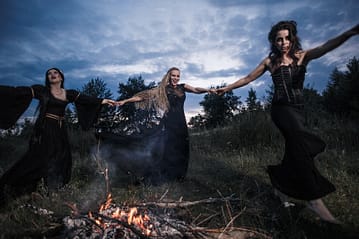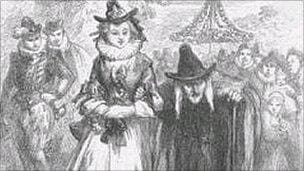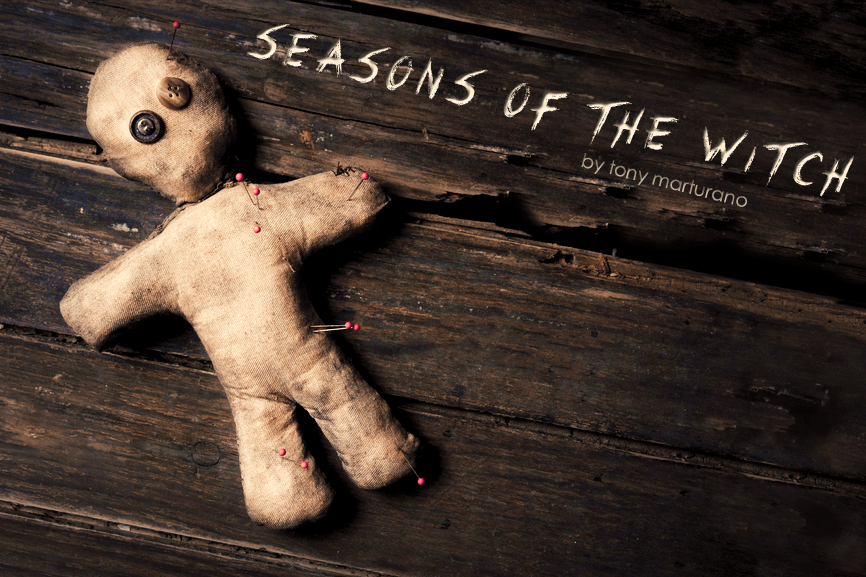SEASONS OF THE WITCH
“Whether or not you believe in the light or dark arts; witchcraft and voodoo practices remain true”
The nights are drawing in, Halloween is only next month, and we’ll soon be entering the dark side of the year.
I’ve just restarted work on my next book INCUBUS, a supernatural thriller, due out next year, and, interestingly, during my research for the book, I came across my own blog post from a few years ago, so I thought I’d share it with you.
Be advised, you may find some parts of this blog post disturbing.
They say that things come in threes, but who exactly are they?
That depends on your beliefs, your interests. If you’re a writer then three tends to be the beginning, the middle and the end of a story; set the scene, build up the tension and then deliver a climactic finale. In Wiccan/Pagan practices, the rule of three tends to be based on the belief that what you put out into the world (positive or negative energy) you will receive back, sometimes ‘threefold.’
“Omne trium perfectum” ‘all threes perfect’.
Halloween; the day when the veil separating the dead and the living is lifted for one night releasing ghosts, goblins, trolls (super heroes in unimaginative households) and witches onto our streets.
If I asked you to describe a witch you’d most likely describe an old hag with a hooked nose, a collection of warts and a gothic wardrobe malfunction. The reality is somewhat different. Real world witches don’t wait for Halloween to make an appearance, nor do they dress in black, and, in this century, they tend to use cars, not broomsticks.
Or do they?
It seems that witches are making a comeback. They had been banished under the weight of vampire, wizard and fantasy novels but recent reports suggest that there’s been a rise in demand for books featuring the Wicca ladies. Playing to this demand were films like, Into the Woods, featuring Meryl Streep, Ryan Murphy’s (creator of Nip Tuck and the surprisingly successful American Horror Story) Coven, Witches of the East End, featuring Julia Ormond, SALEM and so on.
Witches have featured in many fables, and have been persecuted throughout the centuries in a negative context.
However, most witches would argue that their practices don’t seek to cause harm and that this is a stereotype born out of ignorance. They’d say that a real witch’s primary instinct is to love Mother Nature and everything in it. That they are no different to billions of other devout worshippers around the world, only they worship Wicca; a religion influenced by pre-Christian beliefs that observes seasons and life cycles and affirms the existence of supernatural power (Magick) and of both male and female deities who inhere in nature.
The word Wicca was derived from the Anglo Saxon word ‘wicce’, which means to have

The witching hour – Witchcraft is still practised today, but its true motivation remains unknown.
wisdom, so as to bend or shape like a wicker for a basket. Wicca actually stands for a male witch. A female witch is called a ‘wicce’
Curiously, not all witches were assumed to be harmful practitioners of the craft. The term ‘witch doctor’ was in use in England before it came to be associated with Africa and then, of course, New Orleans. ‘Toad Doctors’ were also credited with the ability to ‘undo’ evil witchcraft.
Yet, it’s the belief in Magick and the practice in associated spells that has led to the demise of many throughout time as it was believed that the powers of Magick originate from the devil with whom witches align themselves in order to possess their powers. Thus witches (or wizards) engaged in such practices were alleged to reject Jesus and sacraments and perform infernal rites that parody mass or other sacraments of the church by instead paying honour to the Prince of Darkness in thanks for his gift of supernatural power. Indeed, it is folkloric belief that a witch is branded, like the brand on cattle, by the devil to signify that a pact had been made.
One of the most infamous persecutions in British history is that of the Pendle Witches of Lancashire.
1612, a turbulent time in England, an era rife with religious persecution and superstition. Local magistrates, eager to find favour with a superstitious King, became particularly overzealous in their persecutions and committed to making an example of all of those suspected of devil worship and witchcraft.
In August 1612, ten people were executed on the Moors of Lancashire, having been tried and found guilty of witchcraft at Lancaster castle. Specifically, they had been charged with causing madness, making clay images and using witchcraft to murder sixteen people over twenty years although the evidence against them was flimsy, based on hearsay and superstition. Evidence that wouldn’t even have been entertained in modern day court. Nonetheless, ten people from the Pendle area lost their lives, five of which were from two families, each having implicated the other.

England, 1612 – The person who became known as Old Chattox is accused of witchcraft.
At the head of the group of the accused were two women in their eighties; Elisabeth Southern (who was also known as Old Demdike) and Anne Whittle (known as Old Chattox). The two women existed by begging and by their reputations as ‘wise ones’. They claimed to have the power to remove curses and heal. The demise of these women and members of their families and friends came about when Demdike’s granddaughter, Alizon, was out one day begging. She came across a Halifax peddler and asked him for pins. When the peddler refused, she cursed him. The man collapsed almost immediately, paralysed, unable to speak…or so the story goes.
The matter was brought to the attention of local magistrate, Roger Nowell. Alizon was accused of witchcraft. The event sparked a major witch hunt. Shortly after, she confessed to the crime and then implicated members of her own family and neighbours.
The rest, as they say, is history.
Fast forward a few years to 1692, when the collapse and the fitting of a group of young girls sparked one of the most famous witch hunts and trials in the world. The event took place in the village of Salem, Massachusetts, USA. The girls were believed to have been possessed by the devil. They, in turn, implicated several local women of witchcraft, igniting a wave of hysteria that spread through the colonial state like wildfire forever searing into history one of the country’s most brutal, bitter and notorious persecutions.
I guess it’s no coincidence that all of this took place at a time when religious persecution and devil superstition was so ingrained in society, each and every citizen feared behaving like or becoming embroiled in anything remotely out of the ordinary. These days, the collapse of the so called peddler of Halifax could well have been diagnosed as a stroke whilst the condition of the ‘teenage’ girls could be attributed to a variety of mental health ailments, including puberty!
The only terror here is the one that has transcended generations, the terror of the unknown. It’s the only thing that remains a clear and present danger to our existence. For many of us, fear, terror, panic, and hysteria are all born out of our ignorance of the facts. An irrational fear of the dark and what we cannot see, a rash on the skin of a stranger, the rucksack on the back of an introvert. Our basic, indigenous and primaeval fears stay with us despite our modern day evolution.
Most of these fears are irrational but what about the ones that aren’t?
Kindoki may be just the belief of witchcraft or the possession of evil spirits but it’s the

Fear of the unknown – Our biggest fears are born out of the things we do not understand or cannot see.
result of this belief that proved to be the real the real malevolent force for 15-year-old London tourist, Kristy Bamu, who was tortured and eventually drowned in a bath at the Newham, London home of his sister, Magalie Bamu, aged 29, and Eric Bikubi, 28. Both Eric and Magalie were originally from the Democratic Republic of Congo. The two stood accused of murdering Kristy. During their trial, the court heard that Bikubi accused Kristy and his siblings of bringing Kindoki (or witchcraft) into his home. He then beat all of them although it was Kristy who became the subject of Bikubi’s rage. He accused the teenager of casting spells on the other children in the home and beat him with an iron bar until the teenager begged to die. When paramedics eventually entered the home, they found walls and the ceiling spattered in blood, the teenager drowned in the bath and his siblings hiding terrified and hysterical.
It was later revealed that Bikubi’s paranoid delusion that Kristy was practising Kindoki was actually born out of the fact that he was mentally ill after tests revealed he actually had a lesion on the brain.
Really?
The fact that something like this can take place in modern day society adds bitter sad perspective to what it must have been like for the innocent of yesteryear who fell afoul of ignorance, paranoia, hysteria, and mental instabilities.
That said, the practice of witchcraft and voodoo remains very much alive today as it has for centuries. You need only search online for associated spells and you’ll be presented with a myriad of books and even online ‘free’ spells guaranteed to weave the proverbial magic over any wrinkle in your cosmic universe. From gambling addictions to love potions, everything is covered with candles, some garden herbs and a few verses of text.
Regardless of whether or not you believe in the dark or light arts, one fact remains; for as long as humans struggle with everyday reality they will always seek escapism in the mysticism of television dramas and salvation from the magical.
Sometimes believing is seeing.
Have a magical Sunday.

Leave a Reply